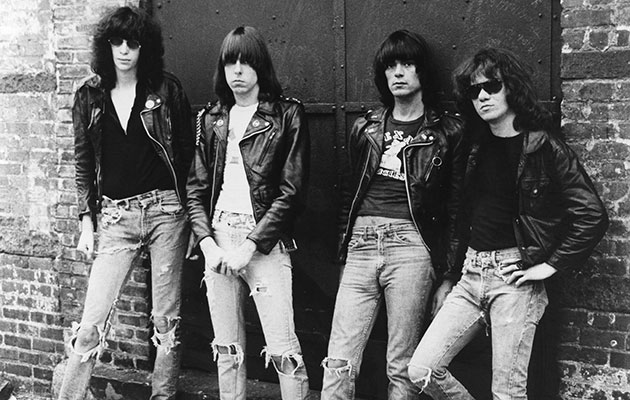The Ramones made their debut on March 30, 1974 at Performance Space, the studio Erdelyi ran with old schoolfriend Monte Melnick. A chaotic set concluded with Dee Dee stepping on the neck of his bass and breaking it.
“Oh my God, they were raw,” remembers Melnick, who attended those early rehearsals. “The Ramones were so bad, forget about it. It was painful.” In front of around 30 friends, the band blasted out seven brutishly brief songs, all written by themselves with self-explanatory, brattish, titles – “I Don’t Wanna Go Down To The Basement”, “I Don’t Wanna Walk Around With You”, “Now I Wanna Sniff Some Glue”, “I Don’t Wanna Be Learned/I Don’t Wanna Be Tamed”, “I Don’t Wanna Get Involved With You”, “I Don’t Like Nobody That Don’t Like Me” and “Succubus”.
Inevitably, there were teething problems. “Joey’s hands would blister up and start bleeding, and after every song his drums would fall apart,” explains Erdelyi. “After two or three songs Dee Dee would get hoarse so Joey would sing, and he had a really good voice. I thought Joey would look good as a lead singer because he wasn’t the cliché of a lead singer. We tried out new drummers and eventually the guys said I should play drums. My drums locked into what Johnny was doing on the guitar. All of a sudden the sound of the Ramones came together.” Erdelyi became Tommy Ramone, the Ramones were a quartet.
Even at this early stage, the band were developing their trademarks. Dee Dee introduced songs with a bellowed “1-2-3-4”, Tommy drummed like a guitarist, Johnny played chainsaw guitar, all thunderous down-strokes and unique in style, while gangling hairball Joey sang crazy, funny songs in a weird Brooklyn-mockney yelp. “From very early, he sang with this strange British accent,” laughs Erdelyi. “I don’t know where it came from, maybe his love of Herman’s Hermits, but we encouraged it, we thought it was cool because it was different.” The content of the songs was also unusual. “We liked horror comics, B-movies, Mad magazine,” lists Erdelyi.
“At that time, everybody was so serious that anybody who used humour couldn’t be taken seriously. They thought we were retarded and on the surface, it might have seemed that way. You had to have intellect to get the Ramones. We had an encyclopaedic knowledge of music and all forms of culture. We had our tastes and they’d get filtered and the crap thrown out.”
On August 16, 1974 the Ramones made their debut as a four-piece at CBGB’s in the Bowery. “It was under a flophouse where you could get a cot for $1.65,” says Television guitarist Richard Lloyd. “There’d always be passed-out bums on the sidewalk outside. We found this place and started to play every Sunday. We decided to do double features, two bands alternating two sets each. There was dogshit on the stage, and urine and wine dripping from the ceiling, but it was an incubator.”
Bands treated CBGB’s as a live rehearsal space, with an audience full of fellow musicians including members of Blondie, Talking Heads, the Heartbreakers, Patti Smith’s band and Television. The Ramones were regulars, working on their stage show almost as diligently as they worked on their songs. Soon, they had developed a uniform of sorts – leather jackets, jeans, trainers and Beatles haircuts. “It was a bit constructed,” notes The Damned’s drummer Rat Scabies. “But if only one of them dressed like that, nobody would have noticed. They realised a small collective makes a louder noise.”
Roberta Bayley, a photographer who was dating Richard Hell, worked the door at CBGB’s while Television were performing. “I first saw the Ramones at Performance Space Studio on 20th Street with Richard. It was like a showcase and they were in a very primitive state. Then they started playing CBGB’s, opening for Television. At first, it seemed like a comic act. You couldn’t believe what you were seeing. They were very simplistic and their songs were always very short, fast and there weren’t many of them. But they went down great because there were only 14 people there. That’s really not an exaggeration, that’s how many people were there in those days. We all knew each other. From very early on they were in leather, although there are photos of Johnny in gold lamé pants before they found the uniform.”
Marc Bell, drummer for Wayne County’s band, caught one of those early CBGB’s gigs. “They weren’t fully developed image-wise, John and Joey were in satin pants and Dee Dee had these shirts with the collar buttoned high. The next time I saw them, they were in brand new leather jackets. They were sloppy, they had to stop songs and go back to recount the intro, they’d argue about songs, but that’s how it was, we were there to hone our skills.”
“Those early shows were chaos,” Erdelyi agrees. “They acted like The Three Stooges at times.”
“They were complex, strange, mutant personalities,” adds Lenny Kaye. “The fact they could get together and make music is a great triumph of what music exists for. It’s a place to channel your weirdness into something that is magical, and the Ramones were certainly magical.”
“They were all dazzlingly intelligent and that manifested itself in radically different ways,” says Danny Fields, who later became their manager. “Tommy was quiet but very organised. He loved detail. Dee Dee pretended to be dumb and crazy. He was crazy but not dumb, but liked being seen as out-of-control. He was the clown everybody wanted to fuck. He was a great songwriter and a great poet in his bizarre, very funny, very charming, way. Joey was one of the strangest people I ever knew, so full of irony. I could never work out whether he meant something, was being droll or was just rolling it around in his incredible mind. Johnny was ferociously smart and strict, definitively scrupulous. He could be cruel, mean, difficult, but he had a superb sense of justice and he was always right, as unpleasant as it often was to be on the end of one of his lectures. It was like the four weirdest kids in the neighbourhood and they hated each other right from the beginning, the way teenagers hate each other.”
For now, though, the band were focusing on tightening their set, making it all muscle, no fat. “They had rules,” explains Melnick, by then their road manager. “They never tuned onstage and they never talked between songs. It was 1-2-3-4 song, 1-2-3-4 song after song after song. I’d hang up their jackets after the show and they’d be soaking wet with sweat. Sometimes the next day they still weren’t dry.”
“It requires a great deal of physical strength to play those downstrokes for half-an-hour,” notes Kaye. “It’s exhausting to keep that sense of metric propulsion going.”
“Over 23 minutes Led Zeppelin couldn’t match them,” says Richard Lloyd.



